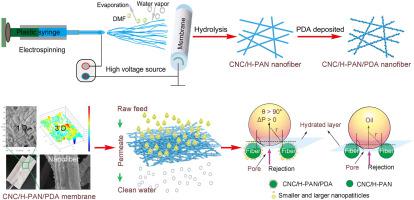当前位置:
X-MOL 学术
›
J. Membr. Sci.
›
论文详情
Our official English website, www.x-mol.net, welcomes your feedback! (Note: you will need to create a separate account there.)
Hybrid membranes based on electrospun nanofiber modified with PDA for selective oil-in-water emulsion separation
Journal of Membrane Science ( IF 9.5 ) Pub Date : 2024-02-28 , DOI: 10.1016/j.memsci.2024.122610 Haiying Yang , Xinhui Wang , Xuanyu Chen , Yonggui Wang , Dong Wang , Wanli Cheng , Guangping Han
Journal of Membrane Science ( IF 9.5 ) Pub Date : 2024-02-28 , DOI: 10.1016/j.memsci.2024.122610 Haiying Yang , Xinhui Wang , Xuanyu Chen , Yonggui Wang , Dong Wang , Wanli Cheng , Guangping Han

|
Separation membranes for water remediation require structural stability, efficient operation, and durability. In this work, we synthesize hierarchical nanofibrous membranes composed of polyacrylonitrile (PAN) reinforced with cellulose nanocrystals (CNC) and polydopamine (PDA). Hydrolysis endows the PAN nanofibers with rich carboxyl functional groups and forms a hydrogen-bonded cross-linked network with CNC. This process helped maintain the structural integrity of the membrane and developed swelling resistance, which was lacking in the CNC/PAN membrane. In a further PDA modification, PDA could still firmly adhere to the nanofiber surface even after sonication or homogenization treatment, showing a high surface roughness (Ra = 2.86 nm). Finally, the membrane displayed a tensile strength of 4.19 MPa, while the pore size was around 0.67 μm. The special wettability and pore structure of the membrane can trap more water, forming an oil/water/solid interface, thereby reducing the contact between oil droplet and membrane and effectively preventing the escape of tiny oil droplets, allowing water to permeate rapidly (oil-repellency in an aqueous). For example, in the phase separation test of three oil-in-water (O/W) emulsions (n-hexane, diesel, toluene), the separation efficiency of the O/W emulsion remained above 93% after 20 filtration cycles, which allowed regeneration and cyclic operation. The proposed method is a novel route to prepare non-swellable yet hydrophilic membranes comprising highly interconnected channels while exhibiting mechanical and structural integrity.
中文翻译:

基于 PDA 改性电纺纳米纤维的混合膜用于选择性水包油乳液分离
用于水体修复的分离膜需要结构稳定性、高效运行和耐用性。在这项工作中,我们合成了由纤维素纳米晶体(CNC)和聚多巴胺(PDA)增强的聚丙烯腈(PAN)组成的分层纳米纤维膜。水解赋予PAN纳米纤维丰富的羧基官能团,并与CNC形成氢键交联网络。这一过程有助于保持膜的结构完整性并提高抗溶胀性,而这是 CNC/PAN 膜所缺乏的。在进一步的PDA修饰中,即使经过超声处理或均质化处理,PDA仍能牢固地粘附在纳米纤维表面,表现出较高的表面粗糙度(Ra = 2.86 nm)。最终,膜的拉伸强度为4.19 MPa,孔径约为0.67 μm。膜特殊的润湿性和孔隙结构可以截留更多的水,形成油/水/固体界面,从而减少油滴与膜的接触,有效阻止微小油滴的逸出,使水快速渗透(油-在水溶液中具有排斥性)。例如,在三种水包油(O/W)乳液(正己烷、柴油、甲苯)的相分离测试中,O/W乳液在20个过滤循环后的分离效率仍保持在93%以上,这允许再生和循环操作。所提出的方法是一种制备不可溶胀但亲水性膜的新途径,该膜包含高度互连的通道,同时表现出机械和结构完整性。
更新日期:2024-02-28
中文翻译:

基于 PDA 改性电纺纳米纤维的混合膜用于选择性水包油乳液分离
用于水体修复的分离膜需要结构稳定性、高效运行和耐用性。在这项工作中,我们合成了由纤维素纳米晶体(CNC)和聚多巴胺(PDA)增强的聚丙烯腈(PAN)组成的分层纳米纤维膜。水解赋予PAN纳米纤维丰富的羧基官能团,并与CNC形成氢键交联网络。这一过程有助于保持膜的结构完整性并提高抗溶胀性,而这是 CNC/PAN 膜所缺乏的。在进一步的PDA修饰中,即使经过超声处理或均质化处理,PDA仍能牢固地粘附在纳米纤维表面,表现出较高的表面粗糙度(Ra = 2.86 nm)。最终,膜的拉伸强度为4.19 MPa,孔径约为0.67 μm。膜特殊的润湿性和孔隙结构可以截留更多的水,形成油/水/固体界面,从而减少油滴与膜的接触,有效阻止微小油滴的逸出,使水快速渗透(油-在水溶液中具有排斥性)。例如,在三种水包油(O/W)乳液(正己烷、柴油、甲苯)的相分离测试中,O/W乳液在20个过滤循环后的分离效率仍保持在93%以上,这允许再生和循环操作。所提出的方法是一种制备不可溶胀但亲水性膜的新途径,该膜包含高度互连的通道,同时表现出机械和结构完整性。



























 京公网安备 11010802027423号
京公网安备 11010802027423号